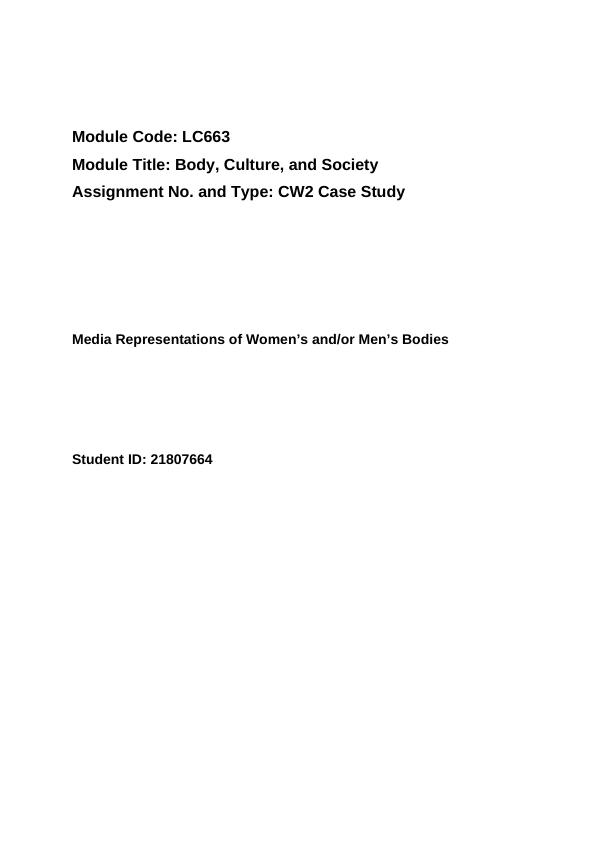CW2 Case Study: LC663 : Body, Culture, and Society
10 Pages3452 Words23 Views
Added on 2022-09-29
CW2 Case Study: LC663 : Body, Culture, and Society
Added on 2022-09-29
ShareRelated Documents
Module Code: LC663
Module Title: Body, Culture, and Society
Assignment No. and Type: CW2 Case Study
Media Representations of Women’s and/or Men’s Bodies
Student ID: 21807664
Module Title: Body, Culture, and Society
Assignment No. and Type: CW2 Case Study
Media Representations of Women’s and/or Men’s Bodies
Student ID: 21807664

P a g e | 2
Introduction
This case study is on media representation of women’s body. Media representation
on male or female body is one of the areas that has received significant interest from
the researchers. This research area has mainly explored the impact of images of
attractive and thin females, or males with distinctly developed muscles, on those
view them (Burrowes, 2013). Additionally, in recent years, there is an increasing
awareness among parents, mental healthcare professionals, child advocates
regarding the influence of mass media and the impact of advertising and media
consumption on the body image of people (House of Commons Women and
Equalities Committee, 2021). Previously, it was viewed that negative body image is
normally perceived as a problem of young females, but research has demonstrated
that the consequences of body image on media are broader issues (House of
Commons Women and Equalities Committee, 2021). For example, the House of
Commons Women and Equalities Committee (2021) has noted that more than 33%
of adult individuals demonstrated their anxiousness or depression regarding their
body image, and approximately half of them wanted to see more diversities in the
mainstream media. Similarly, cited in the House of Commons Women and Equalities
Committee (2021), a study conducted by the UK’s National Health Service (NHS)
demonstrated that nearly 60% of young adults expressed that they experienced
pressure on the social media for looking good, and nearly one-fourth of them opined
that they should have a perfect male body. Another study carried out by the Mental
Health Foundation, cited in the House of Commons Women and Equalities
Committee (2021), found that nearly half (44%) of the LGBT (Lesbian, Gay,
Bisexual, and Transgender) adults experienced shame due to their body image.
Furthermore, a survey conducted by Trailblazers, cited in the House of Commons
Women and Equalities Committee (2021), demonstrated that 80% of the disabled
individuals opined that their body images directly affect their mental wellbeing. All the
outcomes of these studies suggest that body image has a significant impact on
people, and thus it is necessary to assess the causes of poor body image, how it
affects individuals through mass media, and what policies the government can adopt
to tackle the negative effect of body image through mass media on individuals.
Introduction
This case study is on media representation of women’s body. Media representation
on male or female body is one of the areas that has received significant interest from
the researchers. This research area has mainly explored the impact of images of
attractive and thin females, or males with distinctly developed muscles, on those
view them (Burrowes, 2013). Additionally, in recent years, there is an increasing
awareness among parents, mental healthcare professionals, child advocates
regarding the influence of mass media and the impact of advertising and media
consumption on the body image of people (House of Commons Women and
Equalities Committee, 2021). Previously, it was viewed that negative body image is
normally perceived as a problem of young females, but research has demonstrated
that the consequences of body image on media are broader issues (House of
Commons Women and Equalities Committee, 2021). For example, the House of
Commons Women and Equalities Committee (2021) has noted that more than 33%
of adult individuals demonstrated their anxiousness or depression regarding their
body image, and approximately half of them wanted to see more diversities in the
mainstream media. Similarly, cited in the House of Commons Women and Equalities
Committee (2021), a study conducted by the UK’s National Health Service (NHS)
demonstrated that nearly 60% of young adults expressed that they experienced
pressure on the social media for looking good, and nearly one-fourth of them opined
that they should have a perfect male body. Another study carried out by the Mental
Health Foundation, cited in the House of Commons Women and Equalities
Committee (2021), found that nearly half (44%) of the LGBT (Lesbian, Gay,
Bisexual, and Transgender) adults experienced shame due to their body image.
Furthermore, a survey conducted by Trailblazers, cited in the House of Commons
Women and Equalities Committee (2021), demonstrated that 80% of the disabled
individuals opined that their body images directly affect their mental wellbeing. All the
outcomes of these studies suggest that body image has a significant impact on
people, and thus it is necessary to assess the causes of poor body image, how it
affects individuals through mass media, and what policies the government can adopt
to tackle the negative effect of body image through mass media on individuals.

P a g e | 3
Discussion
To analyse the effects of body image on individuals, it is necessary to define the
term ‘body image’. In literature, the term ‘body image’ has evolved around two
themes, such as body perception, and body satisfaction (Burrowes, 2013). In a rapid
evidence assessment of the literature, Burrowes (2013) noted that body perception
refers to the assessment carried out by an individual regarding his/her physical body
aspects and the level to which this evaluation is accurate. Due to the extremely
negative body perception, Burrowes (2013) noted that people may suffer from BDD
(Body Dysmorphic Disorder), which is associated with a psychological disorder that
results in eating disorders when people develop highly inaccurate perceptions
regarding their body size. The second theme is related to body satisfaction, which
refers to the degree to which a person is content with his/her body size and shape
(Burrowes, 2013). According to Burrowes (2013), this theme incorporates various
aspects, such as confidence in body, self-esteem, and dissatisfaction regarding
body. Therefore, body image refers to an individual’s perception or satisfaction
regarding his/her body (Burrowes, 2013). Smolak and Thompson (2009) defined
body image as an individual’s perception regarding his/her physical self and the
resultant feelings and thoughts from their perceptions regarding their body.
According to Smolak and Thompson (2009), the perceptions and feelings individuals
developed regarding their body could be positive, negative, or mixed, and these
perceptions and feelings are influenced and determined through the personal and
environmental factors.
It should be noted in here that researchers generally do not make any distinction
between what body image to males or females, and thus distinctive studies are
carried out on various ways how each of these sexes define body image. Bradley
University’s (2021) ‘The Body Project’ noted that man and women body images have
some commonalities. Hargreaves and Tiggermann (2006) noted that males and
females, boys and girls, could share similar risks factors of body images and the
similar negative consequences of body image, but men are normally less affected
compared to the women. Additionally, men’s body images are based on concerns
Discussion
To analyse the effects of body image on individuals, it is necessary to define the
term ‘body image’. In literature, the term ‘body image’ has evolved around two
themes, such as body perception, and body satisfaction (Burrowes, 2013). In a rapid
evidence assessment of the literature, Burrowes (2013) noted that body perception
refers to the assessment carried out by an individual regarding his/her physical body
aspects and the level to which this evaluation is accurate. Due to the extremely
negative body perception, Burrowes (2013) noted that people may suffer from BDD
(Body Dysmorphic Disorder), which is associated with a psychological disorder that
results in eating disorders when people develop highly inaccurate perceptions
regarding their body size. The second theme is related to body satisfaction, which
refers to the degree to which a person is content with his/her body size and shape
(Burrowes, 2013). According to Burrowes (2013), this theme incorporates various
aspects, such as confidence in body, self-esteem, and dissatisfaction regarding
body. Therefore, body image refers to an individual’s perception or satisfaction
regarding his/her body (Burrowes, 2013). Smolak and Thompson (2009) defined
body image as an individual’s perception regarding his/her physical self and the
resultant feelings and thoughts from their perceptions regarding their body.
According to Smolak and Thompson (2009), the perceptions and feelings individuals
developed regarding their body could be positive, negative, or mixed, and these
perceptions and feelings are influenced and determined through the personal and
environmental factors.
It should be noted in here that researchers generally do not make any distinction
between what body image to males or females, and thus distinctive studies are
carried out on various ways how each of these sexes define body image. Bradley
University’s (2021) ‘The Body Project’ noted that man and women body images have
some commonalities. Hargreaves and Tiggermann (2006) noted that males and
females, boys and girls, could share similar risks factors of body images and the
similar negative consequences of body image, but men are normally less affected
compared to the women. Additionally, men’s body images are based on concerns

End of preview
Want to access all the pages? Upload your documents or become a member.
